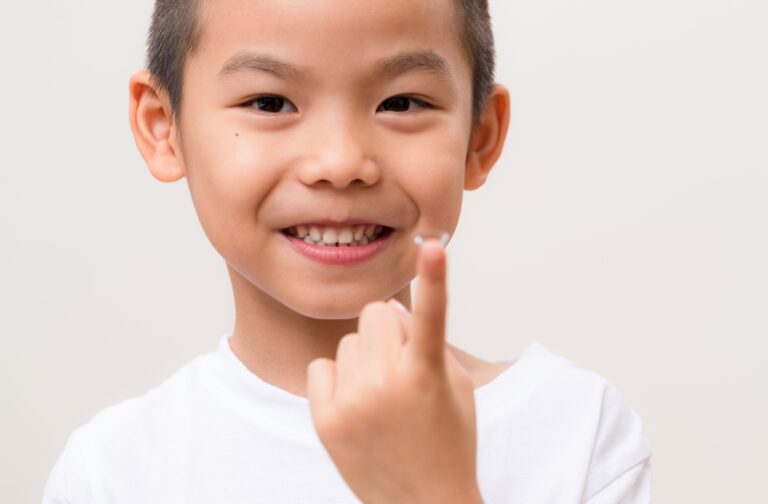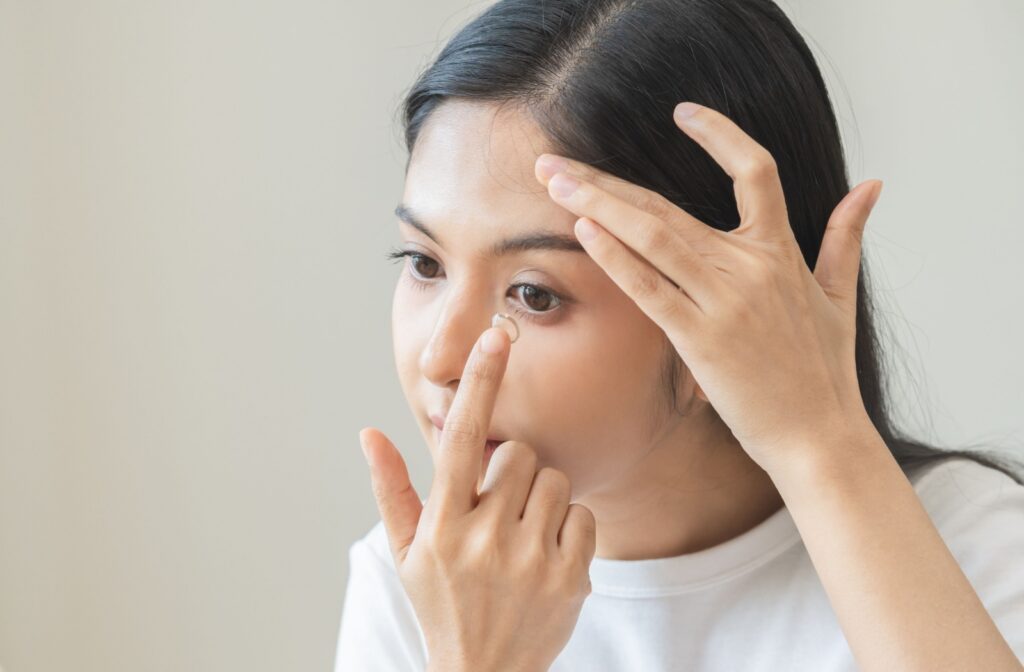Table of Contents

Introduction
Myopia, more commonly referred to as nearsightedness, is an extremely common issue affecting millions of children every year. But there’s good news! Optometrists have several different types of myopia control to help lessen the impact this condition has on your child’s life—like contact lenses. However, many parents wonder if their child is old enough to use contact lenses.
Fortunately, there is no minimum age for contacts! If your child finds them comfortable, then they should be okay to use contacts. But you’ll need to help, especially at first, to make sure they’re using the lenses correctly and properly storing and cleaning them.
What Is Myopia?
Myopia is a common type of refractive error. It’s more commonly known as nearsightedness since it causes nearby objects to be clearly visible while further away objects are blurry.
Myopia is caused by the eye growing too long front-to-back or the cornea being too curved. This causes light to refract incorrectly into the eye and scatter. Your eyes aren’t able to clearly make out far-away objects, and they struggle to make sense of the information they’re getting.
Myopia often causes:
- Difficulty seeing distant objects clearly, such as road signs or a blackboard in class
- Needing to squint or close the eyelids to see clearly
- Headaches due to eyestrain
- Excessive blinking or rubbing of the eyes
- Frequent squinting
This condition typically develops around the age children enter school. It’s progressive, so symptoms typically change and get worse before stabilizing around the age of 18. Fortunately, it’s also considered highly treatable with traditional glasses and contact lenses, so your child isn’t impacted too much!
Can Children Wear Contact Lenses?
Glasses have long been recognized as a way to correct poor vision, but contact lenses are becoming equally popular. But many parents wonder whether or not their child can wear contacts or if that isn’t the best idea.
Fortunately, children can wear contact lenses. But as a parent, you’re going to have to lend a hand—especially at first or when they’re younger. It’s important to:
Teach your child proper hygiene techniques to avoid infections
Ensure they understand the importance of taking out their contacts before bed
Give them a hand putting the lenses in and removing them
It can help to regularly schedule appointments with an optometrist. Your child’s eyes are always changing, and it’s important they stay up-to-date on their prescription. But don’t worry—contact lenses aren’t the only form of myopia control!
What Is Myopia Control?
Remember: myopia is a progressive condition. Since your kid’s eyes constantly change as they’re growing, myopia typically gets worse over time before it stabilizes.
This is when myopia control becomes a popular option. This aims to slow how much the eye actually changes over time. Myopia control tries to slow the growth or elongation of the eye so that the symptoms don’t change too drastically and lessens how much of an impact myopia will have on your child’s future.
Here at Golden Vision Optometry, we offer 3 primary types of myopia control:
- Orthokeratology contact lenses
- MiSight contact lenses
- Atropine eye drops

What Is Orthokeratology?
Orthokeratology, more commonly called ortho-k, is a noninvasive approach to slowing myopia progression. It uses specialty contact lenses to temporarily reshape the eye’s curve so it can refract light properly on its own.
These lenses are worn overnight. While your child sleeps, there’s a gentle bit of pressure applied to the cornea, slowly pushing it into a different shape. Then, you remove the lens in the morning, and your child will have clear vision for the rest of the day!
Ortho-k is safe and there is typically no discomfort or side effects. Ortho-k allows your child to have clear vision without the need for any other kind of vision correction during the day, making it an ideal choice for children struggling with myopia. The lenses are made of a rigid gas-permeable material, so they’re long-lasting with proper care and usage.
How Does MiSight Work?
MiSight is another innovative type of contact lens. But instead of being worn at night like ortho-k, MiSight lenses are worn throughout the day just like any other contact—but with a twist.
They’re designed kind of like a bulls-eye, with different zones radiating out from the center. Each of these zones, shaped like a ring, has a slightly different corrective power. The ones on the outside redirect light from the periphery of the eye to properly reach the retina.
There’s a huge benefit to using MiSight lenses. They’ve actually been shown to reduce myopia progression by almost 50%, which means that using them may preserve more of your child’s vision than standard contacts!
MiSight lenses are made of a soft, comfortable material, which can make them more appealing to kids. They’re typically a daily disposable lens, which means there’s no cleaning involved. However, the lenses should be worn for roughly 10 hours a day, 6 days a week, to get optimal results.
The FDA study for MiSight focused on children ages 8–12, but the contact lenses have been successfully used in children from age 5 to older patients into their 20s. MiSight contact lens use is dependent on whether or not your eye doctor determines this method of myopia control is right for your child.
How Do Atropine Eye Drops Work?
Maybe your child doesn’t want to wear contacts at all. That’s completely okay—not everyone finds them comfortable! This is when atropine eye drops can be an excellent option.
These are specialty eye drops diluted to 0.001% concentration. They temporarily paralyze certain muscles in the eye and can reduce how far myopia progresses. However, they don’t work for everyone, so you’ll need to visit an optometrist to determine whether or not these are a good option.
Personalized Treatment for Your Child
So, what’s the best choice for your child? That depends on their needs, lifestyle, and comfort. Whether it’s contact lenses, ortho-k, MiSight, or atropine eye drops, our team at Golden Vision Optometry in California is here to help you make an informed decision.
Schedule an appointment with us today, and let’s help your child—together.








